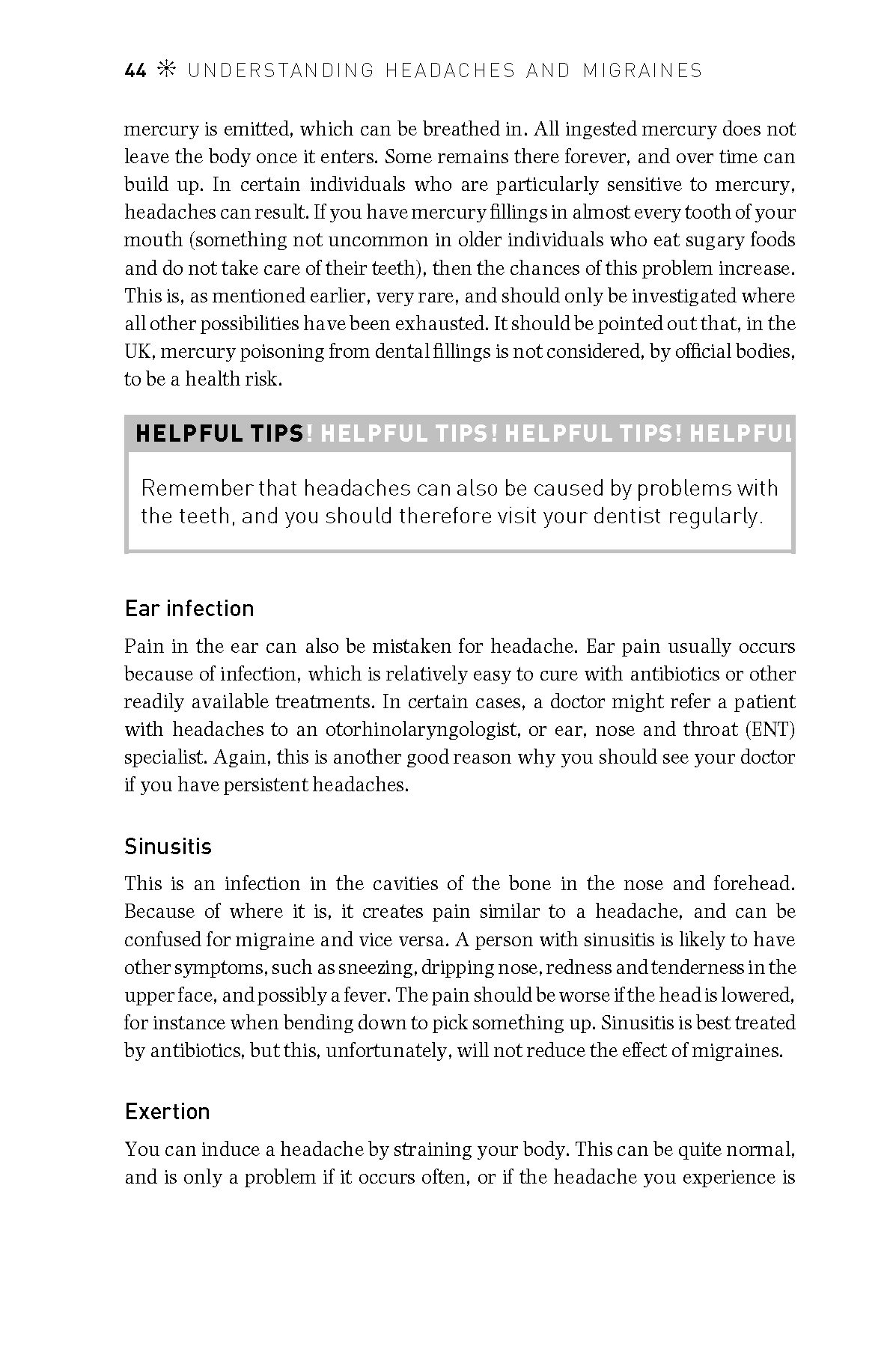UHAM061

44 * UNDERSTANDING HEADACHES AND M IG RAI N ES mercury is emitted, which can be breathed in. Ali ingested mercury does not leave the body once it enters. Some remains there forever, and over time can build up. In certain indmduals who are particularly sensitive to mercury, headaches can result. If you have mercury fillings in almost every tooth of your mouth (something not uncommon in older indmduals who eat sugary foods and do not take care of their teeth), then the chances of this problem increase. This is, as mentioned earlier, very rare, and should only be investigated where all other possibilities ha ve been exhausted. It should be pointed out that, in the UK, mercury poisoning from dental fillings is not considered, by official bodies, to be a health risk.
HELPFUL TIPS
HELPFUL TIPS! HELPFUL TIPS! HELPFUL
Rememberthat headaches can also be caused by problems with the teeth, and you should therefore visit your dentist regularly.
Ear infection
Pain in the ear can also be mistaken for headache. Ear pain usually occurs because of infection, which is relatively easy to cure with antibiotics or other readily available treatments. In certain cases, a doctor might refer a patient with headaches to an otorhinolaryngologist, or ear, nose and throat (ENT) specialist. Again, this is another good reason why you should see your doctor if you have persistent headaches.
Sinusitis
This is an infection in the cavities of the bonę in the nose and forehead. Because of where it is, it creates pain similar to a headache, and can be confused for migraine and vice versa. A person with sinusitis is likely to have other symptoms, such as sneezing, dripping nose, redness andtenderness in the upper face, andpossibly a fever. The pain should be worse if the head is lowered, for instance when bending down to pick something up. Sinusitis is best treated by antibiotics, but this, unfortunately, will not reduce the effect of migraines.
Exertion
You can induce a headache by straining your body. This can be ąuite normal, and is only a problem if it occurs often, or if the headache you experience is
Wyszukiwarka
Podobne podstrony:
UHAM065 48 * UNDERSTANDING HEADACHES AND M IG RAI N ES The Peruvian guide and bus driver were concer
UHAM067 50 * UNDERSTANDING HEADACHES AND M IG RAI N ES solve the problem completely. Caffeine is onl
UHAM063 46 * UNDERSTANDING HEADACHES AND M IG RAI N ES sources: television and Computer screens, and
UHAM081 64 1 UNDERSTANDING HEADACHES AND M IG RAI N ES this is airborne pollen). Some antiłiistamine
UHAM035 18 * UNDERSTANDING HEADACHES AND M IG RAI N ES One particular problem in people in their lat
UHAM037 20 * UNDERSTANDING HEADACHES AND M IG RAI N ES episodes in Life and the onset of a headache.
UHAM039 22 * UNDERSTANDING HEADACHES AND M IG RAI N ES African-Caribbean people or Asian people (in
UHAM041 24 * UNDERSTANDING HEADACHES AND M IG RAI N ES is in intensity rather than quality. In all o
UHAM043 26 * UNDERSTANDING HEADACHES AND M IG RAI N ES A common migraine aura involves a scintiUati
UHAM045 28 * UNDERSTANDING HEADACHES AND M IG RAI N ES own migraine triggers, perhaps by maintaining
UHAM047 30 * UNDERSTANDING HEADACHES AND M IG RAI N ES it. Aft er a migraine attack, I can f ee L w
UHAM049 32 * UNDERSTANDING HEADACHES AND M IG RAI N ES get a full-blown attack. However, I do stillf
UHAM051 34 * UNDERSTANDING HEADACHES AND M IG RAI N ES can mean that I have to dnve everyone around
UHAM055 38 * UNDERSTANDING HEADACHES AND M IG RAI N ES Stress, food, drink and light are aLL common
UHAM057 40 * UNDERSTANDING HEADACHES AND M IG RAI N ES being served the wrong dish in a restaurant a
UHAM059 42 * UNDERSTANDING HEADACHES AND M IG RAI N ES placed on the muscles may leadto chronic head
UHAM073 56 * UNDERSTANDING HEADACHES AND M IG RAI N ES she has ruled out all of the dangerous or lif
więcej podobnych podstron